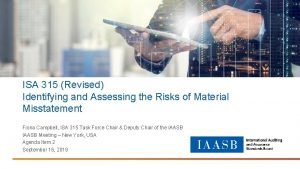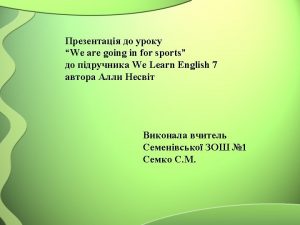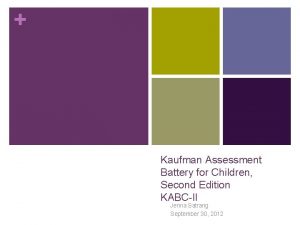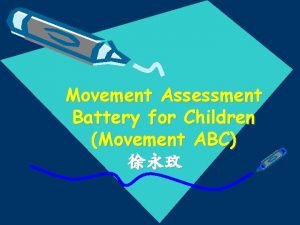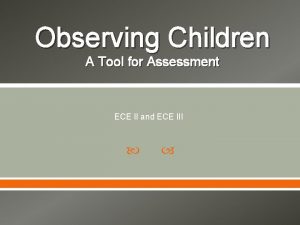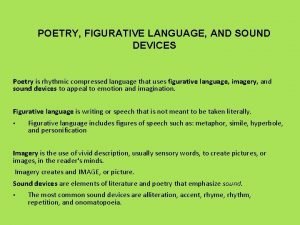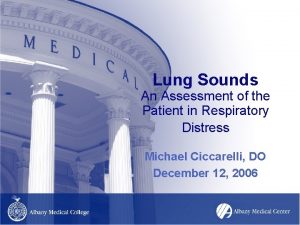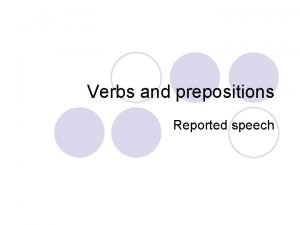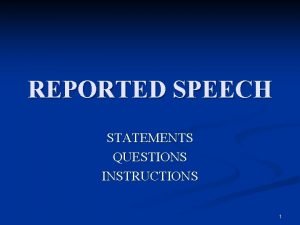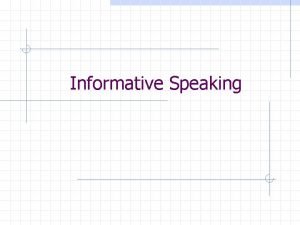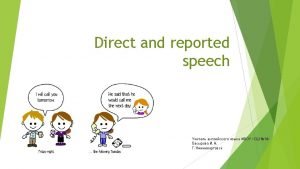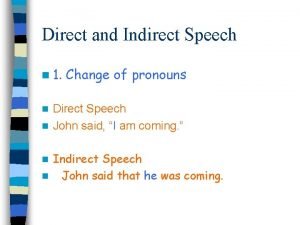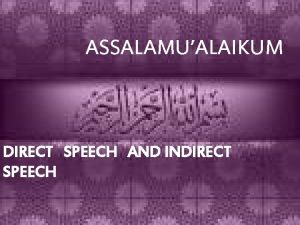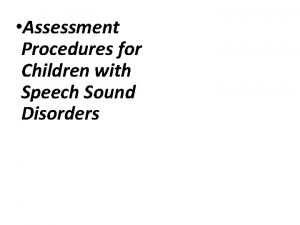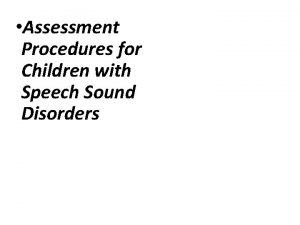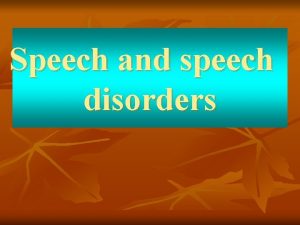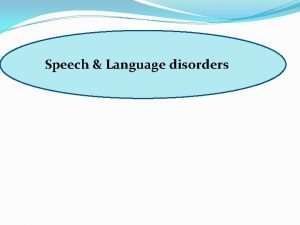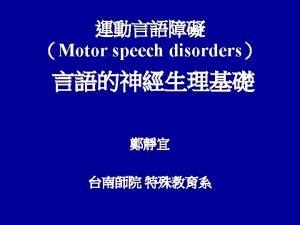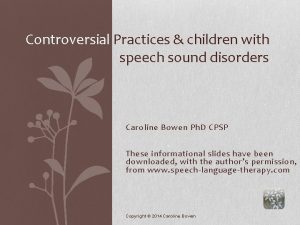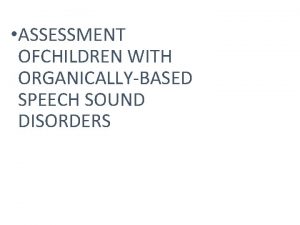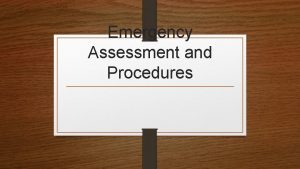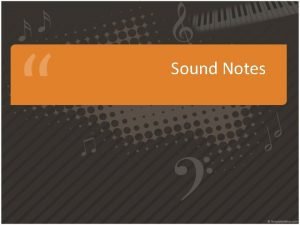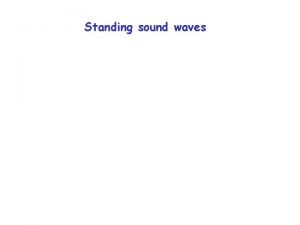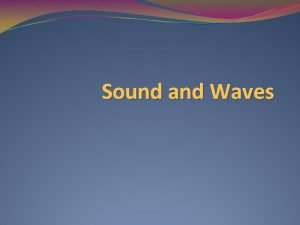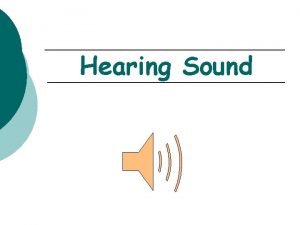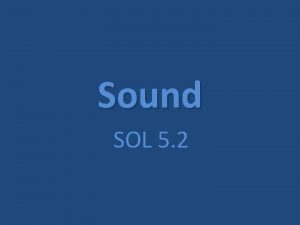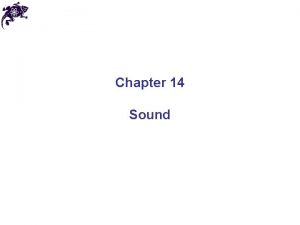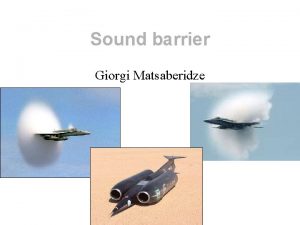Assessment Procedures for Children with Speech Sound Disorders


























































































- Slides: 90

• Assessment Procedures for Children with Speech Sound Disorders

For assessment and other information about speech sound diorders: • http: //www. asha. org/public/speech/disord ers/Speech. Sound. Disorders/

I. INTRODUCTION** • Assessment—set of procedures that are used to gain a clear description of the speech sound production skills of a child—goal is to determine if there is a speech sound disorder

Goals of assessment: ** • 1. Is therapy needed? • 2. What factors are related to the presence or maintenance of the SSD? (e. g. , middle ear infections) • 3. Direction of therapy • 4. Prognostic statement—what will happen with or without therapy • 5. Monitor change over time—is tx effective? Changes needed?

We can do an independent or relational analysis: ** • Relational analysis: describe the child’s productions and compare them to the adult standard of of the speaker’s linguistic community. We’re asking: does the child produce the sounds correctly? • This is what we do with most children

Independent analysis: ** • What speech sounds does the child produce? • We aren’t concerned if they are correct or not • In my experience, this is great for young, highly unintelligible young children

II. SPEECH SCREENINGS** • Screening: pass/fail procedure that can be conducted quickly with a large number of individuals in a short period of time • Id people who need further assessment • No info on test 3 re: specific screening instruments (pp. 152 -153) • Children: converse, say ABCs, count to 10 » Adults—conversation, reading

I screened Emmanuel • 5 years old, Spanish at home— difference or disorder? • Tx or no tx— give him time?

In schools in California

In the schools…** • Put the child on “monitor” status • I say to a kindergarten teacher, e. g. : • “He is still quite young, so I will re-check him again in January. If he still doesn’t technically qualify for speech, I can re-screen him in first grade. ”

III. GENERAL PRINCIPLES OF ASSESSMENT** • A. Review the Client’s Background – 1. Written case history forms – 2. Information from other professionals • 3. Conduct interview

1. Written case history forms

Written forms (continued)** • Speech, lang, developmental hx • Prenatal and birth hx • Medical hx (eating problems, ear infections) • Educational hx • Social hx (ch’s relations with others, discipline problems; is the child frustrated? )

2. Information from other professionals

3. Conduct an interview

We need to ask:

Close the interview** • Recap important points • Be sure to tell the person that you will share test findings with them • Thank them for their time

• B. Plan Assessment Session** • -select appropriate tests • -prepare bribes! (stickers, toys, games, prizes) • C. Prepare Testing Area • Clean and clutter free • Not distracting

• D. Assess Related Areas** (more later) – 1. Hearing – 2. Orofacial structures – 3. DDK syllable rate – 4. Speech rate – 5. Speech intelligibility – 6. Level of stimulability

E. Screen language

Baron et al. (2018). Children with dyslexia benefit from orthographic facilitation during word learning. Journal of Speech, Language, and Hearing Research, 61, 2002 -2014. ** • To review, children with SSD are at increased risk for having difficulty learning to read • In assessment, test phonological awareness

Test PA skills that are especially related to reading deficits (Baron et al. , 2018)

Baron et al. , 2018: ** Also test the child’s ability to repeat complex words (associated with dyslexia) like: Refrigerator Hippopotamus Aluminum Reservation

The question: ** • Does the child’s SSD have an adverse effect on their educational performance? • If not, technically they don’t qualify for speech • Farquharson, K. , & Boldini, L. (2018 October). Variability in interpreting “educational performance” for children with SSD. Language, Speech, and Hearing Services in Schools, 49, 938 -949.

Farquharson & Boldini 2018— Educational performance includes:

Farquharson & Boldini 2018—problems related to educational impact that can come from having an SSD:

• F. Administer Tests** • Get a spontaneous sample • Use standardized tests—some school districts demand norms

• G. Discuss Findings and Make Recommendations

IV. HEARING SCREENING** • SLPs can screen • In the schools, nurse usually does this • Pure tone air conduction thresholds at 20 or 25 d. B • Refer to physician, audiologist if suspect a problem

In hearing testing:

V. DIADOCHOKINETIC SYLLABLE RATES** • DDKs refer to the speed and regularity with which a person produces repetitive articulatory movements • Alternating motion—same syllable /pʌpʌ/ • Sequential motion—different syllables /pʌtʌkʌ/ • We are evaluating oral motor coordination

In evaluating oral motor coordination, we are looking for: ** • Speed • Accuracy • Sequencing problems

VI. CONDUCTING AN ORAL PERIPHERAL EXAMINATION** • A. Purpose • Helps differentiate: functional or organic • Functional: not associated with an organic or neurological impairment • Organic: some underlying structural, sensory, or neurological cause or related factor

B. Supplies** • Penlight, gloves, stopwatch (phone), tongue depressors Tasty tongue depressors are best! Dr. R’s wad ‘o gum technique

C. Assessment of Structure and Function of Facial Muscles** • 1. General symmetry of face at rest— drooping? Twitches? • 2. Facial symmetry during smiling, opening mouth • 3. Structural integrity of lips—drooping? Mouth breathing?


D. Assessment of Structure and Function of Tongue** • 1. Structural integrity—normal color? • Abnormal movements like fasciculations/tremors?

• 2. Functional integrity

• E. Assessment of Hard Palate** • Normal color? • Normal height and width? (too narrow? ) • Clefts?

Narrow, high, vaulted hard palate: (normal, thumb sucker)**

Your book recommends:

• F. Assessment of Soft Palate** • Problems VPI (velopharyngeal incompetence) • Bifid uvula submucous cleft? • Good oral-nasal resonance balance? • Prolong /a/--does velum move up and back to meet pharyngeal wall?

Confirming that velopharyngeal closure is normal…** • Requires specialized procedures • E. g. , an otolaryngologist can view closure from the top with a nasoendoscope inserted through the nose • A radiologist can use lateral fluoroscopic Xray

• G. Assessment of Teeth

watch Haberstock youtube video • Youtube channel Celeste Roseberry

VII. OBTAINING A SPONTANEOUS SAMPLE** n Ideal—most valid and representative sample of phonological performance in daily life n Time-consuming, hard with highly unintelligible children n Some children don’t want to talk with an unfamiliar adult n You may not get a sample of all English phonemes

We can get older children and adults to read a passage out loud: ** • But usually fewer errors occur in reading than in spontaneous speech • For example, in my work with adult accent clients, they use he orthography of the printed word to help them produce sounds correctly; they don’t have these visual cues in spontaneous conversation

Practical tips:

Fogle 2019—when you listen back to the spontaneous sample, you are listening for:

VIII. ADMINISTERING STANDARDIZED TESTS** • A. Introduction • Advantages • -quick (15 -20 min. ) • -sample all consonants • -you know what the highly unintelligible child should be saying

When we assess speech sounds in single words…** • We get a speech sound inventory • The speech sound inventory is phoneme productions that are gathered from a corpus of single-word productions (p. 155)

Disadvantages:

• B. Obtaining Responses** • Direct vs. delayed imitation • C. Recording Responses 1. Plus/minus technique 2. Whole word transcription

3. Record type of error: ** a. Omission (-) b. Substitution t/k, d/g, w/r c. Distortion—D or D 1 -D 3 d. Addition—transcribe whole word

D. Commonly-Used Tests: Phonological Processes** (for the exam, you only have to know the ones in orange font) • 1. Natural Process Analysis (NPA) (8 PPs) • 2. Assessment Link Between Phonology and Articulation (ALPHA) (50 words; transcribe PPs or artic)

• 3. Assessment of Phonological Processes-Revised (APPR; Hodson) 2008 March—APP: 3 (computerized version too)** Severity rating

• 4. Bankson-Bernthal Test of Phonology (BBTOP) (80 words; 9 PPs)** • 5. Khan-Lewis Phonological Analysis (first give Goldman-Fristoe) (10 PPs) • 6. Phonological Process Analysis (12 PPs) (Weiner)

Our clinic uses the CAAP: ** • Clinical Assessment of Articulation and Phonology

E. Commonly-used Tests: Articulation** • 1. Arizona Articulation Proficiency Test-3 • 2. Photo Articulation Test (PAT: 3) • 3. Goldman-Fristoe Test of Articulation: 2 (GFTA: 3 came out in November, 2016) • 4. Test of Minimal Articulation Competency (TMAC)

When you record….

Youtube • GFTA-2 • TAGroup

IX. OTHER TYPES OF ASSESSMENT** • A. Speech Discrimination Testing • Minimal pairs • B. Stimulability Testing • We are sampling the client’s ability to imitate the correct form of error sounds when provided with “stimulation” (e. g. , verbal, tactile, visual cues) • If a child is highly stimulable for a sound, he or she may outgrow their error (e. g. , w/r) without intervention

• C. Contextual Testing** • Mc. Donald’s Deep Test • Secord Contextual Articulation Tests (SCAT) • Special procedure that can help id a facilitative phonetic context for correct production of a particular phoneme—we test a sound in a variety of phonetic contexts

X. ANALYZING AND INTERPRETING ASSESSMENT INFORMATION** • A. Analysis of Speech Sound Production • Independent analysis: child’s productions transcribed without reference to adult model • Id sounds that are in the child’s phonetic inventory • **Relational analysis: compare child’s production to standard/adult form • B. Linear Phonological Error Pattern Analysis (not on test)

• C. Traditional Analysis** • 1. Errors IMF • 2. Error types—omission, distortion, substitution, addition • D. Developmental Analysis • Compare child’s production to norms for CA (**public schools)

• E. Pattern Analysis

2. Place-Voice-Manner

• 3. Phonological Process Analysis** • Analyze PPs in terms of frequency, percentage of occurrence • Total # of occurrences of final cons. deletion = 10 • Total # of opportunities for the process = 50 • Total = 20% occurrence

Review of Phonological Patterns (pp. 182 -184)** • • • 1. Final consonant deletion 2. Weak syllable deletion 3. Reduplication 4. Consonant cluster reduction 5. Epenthesis

• 6. Metathesis—transposition or reveral of** two segments/sounds in a word (baksit/basket) (p. 183) • 7. Velar assimilation (e. g. , guck/duck) • 8. Nasal assimilation (e. g. , nun/nut) • 9. Labial assimilation (e. g. , pipe/type) • 10. Fronting • 11. Backing • 12. Stopping • 13. Liquid gliding • 14. Vocalization (liquids replaced by vowels)

• 15. Deaffrication (e. g. , ship/chip)** • 16. Glottal replacement (glottal stops replace phonemes in the medial or final position of words) • 17. Prevocalic voicing (e. g. , ban/pan) • 18. Final consonant devoicing

Review of patterns disappearing and persisting after 3 years old (p. 191):

Phonological patterns persisting after age 3: • • • Cluster reduction Epenthesis Gliding Vocalization Stopping Final consonant devoicing

• F. Intelligibility Analysis** • Speech intelligibility is a perceptual judgment made by a listener based on the percentage of words in a speech sample that are understood • Usually— subjective statement “This examiner estimates that in a known context with an unfamiliar examiner, Joey is 50% intelligible in connected speech. ”

Please know intelligibility norms:

XI. MAKING A DIAGNOSIS • A. Typical Speech Skills

• B. B. Articulation Disorders— Articulation Disorder

C. Disorders—Phonological Disorder

D. Severity Estimate--Disorder is: ** • Mild-moderate • Moderate-Severe • Profound

E. Diagnostic Statement** • A summary —one of the last portions in a written report It’s very important that this be well done, because it’s all most people ever read (e. g. , parents, principals, pediatricians)

XII. DETERMINING PROGNOSIS** • Prognosis = estimated course of a disorder under specified conditions • E. g. , what will happen if tx is offered—or not? • Variables contributing to prognosis— motivation, intelligence, how much time you have

Roseberry:

3 Major components of a good prognostic statement: ** • 1) goal statement —skills ch expected to achieve—be specific • 2) judgment of success • 3) Prognostic variables that justify the judgment

XIII. MAKING THERAPY RECOMMENDATIONS

For therapy, many clinicians…

Most frequently-occurring sounds are a priority (p. 193)** • /n, t, s, r, l, d, voiced th, k, m, w, z/ • Please know these for the exam • VERY helpful with children, adult accent clients • Also good for Wheel of Fortune!

XIV. CONCLUDING THE ASSESSMENT PROCESS** • Diagnostic report • Conduct information-giving interview

Information-giving interview

Roseberry’s examples: ** • I loved working with Manuel. He is so cooperative and sweet! We will definitely need to enroll him in speech for ****. I look forward to working with him. • Jennifer is so much fun—and so motivated to improve! I am looking forward to seeing her for therapy.

XV. DIAGNOSTIC REPORT** • Legal doc—could end up in the hands of a lawyer without your permission • Typos, other errors are death • People’s first impression of you!
 Looney tunes speech disorders
Looney tunes speech disorders Isa 315 risk assessment procedures
Isa 315 risk assessment procedures “a sound mind is in a sound body”
“a sound mind is in a sound body” The higher the amplitude, the _______the sound.
The higher the amplitude, the _______the sound. Open handed map figure of speech
Open handed map figure of speech Kaufman assessment battery for children-2
Kaufman assessment battery for children-2 Movement abc checklist pdf
Movement abc checklist pdf Observing children a tool for assessment
Observing children a tool for assessment Fspos
Fspos Novell typiska drag
Novell typiska drag Nationell inriktning för artificiell intelligens
Nationell inriktning för artificiell intelligens Returpilarna
Returpilarna Varför kallas perioden 1918-1939 för mellankrigstiden?
Varför kallas perioden 1918-1939 för mellankrigstiden? En lathund för arbete med kontinuitetshantering
En lathund för arbete med kontinuitetshantering Kassaregister ideell förening
Kassaregister ideell förening Personlig tidbok fylla i
Personlig tidbok fylla i Sura för anatom
Sura för anatom Förklara densitet för barn
Förklara densitet för barn Datorkunskap för nybörjare
Datorkunskap för nybörjare Boverket ka
Boverket ka Hur skriver man en tes
Hur skriver man en tes För och nackdelar med firo
För och nackdelar med firo Nyckelkompetenser för livslångt lärande
Nyckelkompetenser för livslångt lärande Påbyggnader för flakfordon
Påbyggnader för flakfordon Tryck formel
Tryck formel Offentlig förvaltning
Offentlig förvaltning Jag har gått inunder stjärnor text
Jag har gått inunder stjärnor text Presentera för publik crossboss
Presentera för publik crossboss Vad är ett minoritetsspråk
Vad är ett minoritetsspråk Plats för toran ark
Plats för toran ark Klassificeringsstruktur för kommunala verksamheter
Klassificeringsstruktur för kommunala verksamheter Mjälthilus
Mjälthilus Bästa kameran för astrofoto
Bästa kameran för astrofoto Centrum för kunskap och säkerhet
Centrum för kunskap och säkerhet Byggprocessen steg för steg
Byggprocessen steg för steg Bra mat för unga idrottare
Bra mat för unga idrottare Verktyg för automatisering av utbetalningar
Verktyg för automatisering av utbetalningar Rutin för avvikelsehantering
Rutin för avvikelsehantering Smärtskolan kunskap för livet
Smärtskolan kunskap för livet Ministerstyre för och nackdelar
Ministerstyre för och nackdelar Tack för att ni har lyssnat
Tack för att ni har lyssnat Vad är referatmarkeringar
Vad är referatmarkeringar Redogör för vad psykologi är
Redogör för vad psykologi är Matematisk modellering eksempel
Matematisk modellering eksempel Tack för att ni har lyssnat
Tack för att ni har lyssnat Borra hål för knoppar
Borra hål för knoppar Orubbliga rättigheter
Orubbliga rättigheter Stickprovsvariansen
Stickprovsvariansen Tack för att ni har lyssnat
Tack för att ni har lyssnat Rita perspektiv
Rita perspektiv Ledningssystem för verksamhetsinformation
Ledningssystem för verksamhetsinformation Tobinskatten för och nackdelar
Tobinskatten för och nackdelar Toppslätskivling dos
Toppslätskivling dos Datumr
Datumr Egg för emanuel
Egg för emanuel Elektronik för barn
Elektronik för barn Mantel för kvinnor i antikens rom
Mantel för kvinnor i antikens rom Strategi för svensk viltförvaltning
Strategi för svensk viltförvaltning Kung dog 1611
Kung dog 1611 Indikation för kejsarsnitt på moderns önskan
Indikation för kejsarsnitt på moderns önskan Ro i rom pax
Ro i rom pax Tack för att ni lyssnade
Tack för att ni lyssnade Samlade siffror för tryck
Samlade siffror för tryck Rim till lärare
Rim till lärare Inköpsprocessen steg för steg
Inköpsprocessen steg för steg Rbk-mätning
Rbk-mätning Ledarskapsteorier
Ledarskapsteorier Exspektans eller expektans
Exspektans eller expektans Myndigheten för delaktighet
Myndigheten för delaktighet Trög för kemist
Trög för kemist Tillitsbaserad ledning
Tillitsbaserad ledning Läkarutlåtande för livränta
Läkarutlåtande för livränta Vad är en punkthöjd
Vad är en punkthöjd Gumman cirkel sång
Gumman cirkel sång Shivaismen
Shivaismen Meios steg för steg
Meios steg för steg Bris för vuxna
Bris för vuxna Big brother rösta
Big brother rösta How many vowel sounds in spanish
How many vowel sounds in spanish Sonic devices poetry
Sonic devices poetry Lung sound assessment
Lung sound assessment Match the tenses in direct and reported speech
Match the tenses in direct and reported speech Pure speech definition
Pure speech definition Speech to the young gwendolyn brooks
Speech to the young gwendolyn brooks Reported speech statements and questions
Reported speech statements and questions Informative speech vs persuasive
Informative speech vs persuasive Direct speech present continuous
Direct speech present continuous Reported speech should
Reported speech should Reported speech wh questions
Reported speech wh questions Into reported speech
Into reported speech A speech to the young
A speech to the young

